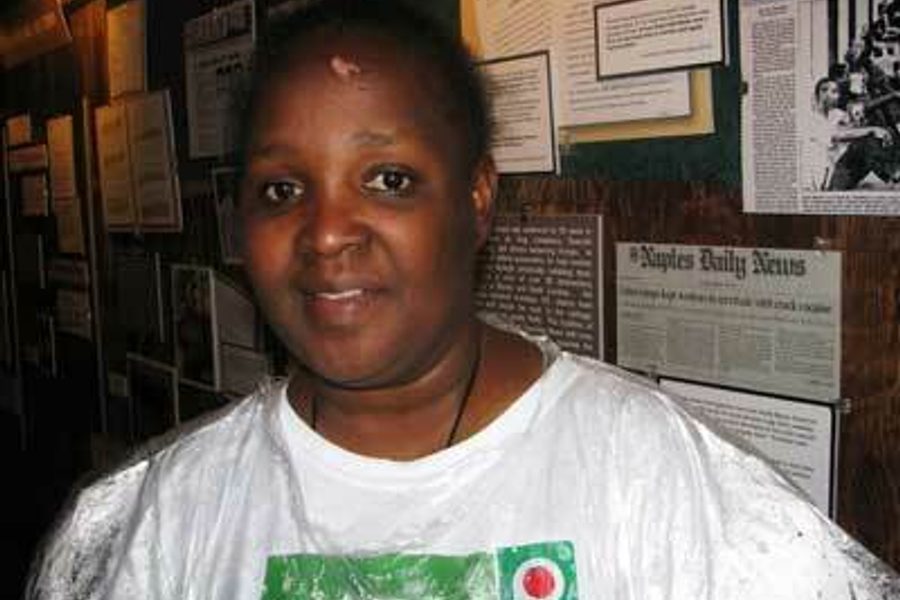
It was a tight squeeze for the 14 people inside the Florida Modern Day Slavery museum, standing shoulder to shoulder as they viewed the images and information mounted on the inside of the 24-square-foot semi-trailer.
The traveling slavery museum highlights horrifying and very recent instances of literal slavery in south Florida, situations that might never have gained the attention of law enforcement and the general public if it weren’t for the Coalition of Immokalee Workers and their supporters, including the Student/ Farmworker Alliance and interfaith groups nationwide. (Since 1997, the coalition has played a key role in seven slavery-related prosecutions, freeing more than 1,000 workers and targeting a dozen employers.)
Almost 1,000 Immokalee workers and supporters turned out on a rainy, humid day in Lakeland, Fla., yesterday (April 18) to celebrate the end of the three-day, 25-mile Farm Worker Freedom March meant to publicize the plight of farm workers and pressure the Publix Supermarkets chain to sign an agreement promising to buy only from growers who improve working conditions and pay workers an extra penny per pound of tomatoes.
“That’s not much, but for us it’s a big help,” said Miguel Sanchez, a 54-year-old immigrant from Chiapas, Mexico, as he gestured at a basket of green tomatoes by a display about Florida slavery through the ages.
Sanchez, who has been at Immokalee for five years, believes Publix will sign an agreement. More important to him than the pay increase, though, is that employers stop abusing workers and treat them with respect. “They don’t give us water breaks or food, just so many things, so much mistreatment,” he said.
The display highlighted Florida’s long and shameful history of slavery, putting the abuse of today’s migrant workforce in context with the African slave trade, peonage of white workers, chattel slavery and use of chain gangs. Exhibits noted that about 44 percent of Florida’s total population was enslaved in 1860, and there were fewer than 1,000 free black people in the state at the start of the Civil War. The museum includes a slave auction poster; an improvised oil lamp from an early 20th century labor camp – a rag stuffed in a bottle of Bacco Black Jack orange wine; and the bloodied shirt of a teenage immigrant worker beaten in 1996 for stopping for water.
The traveling museum, which toured the state during the past month and may head to Washington D.C., includes grim photos of black convicts in striped uniforms, desperately poor white families and other enslaved workers tapping turpentine, logging, cutting sugar cane and doing other back-breaking labor.
Roslyn Tompkins, 44, learned about the Immokalee workers’ struggle while studying organizational leadership at St. Thomas University in Miami. “They’re being paid 49 cents a pound for those tomatoes. I went to Publix yesterday and tomatoes were selling for $3.58 a pound,” she said.
Claudia de la Cruz, 29, is a pastor at a Bronx church and sees the farmworkers movement as part of larger struggles, including immigrant restaurant workers the church supports and the Movimiento Sin Tierra in Brazil, for whom the church does solidarity work:
In New York City we don’t have farms but we have factories, we have exploitation as well,” she said. “How do we learn from international and national strategies to work in our own community? Workers need to realize the connections, and work together to deconstruct the whole system and reconstruct one based on the needs of people, not on exploitation.
Aside from a few hecklers who shouted out from cars, marchers reported widespread support on their march. It consisted of a 10-mile trek through working-class Tampa neighborhoods on Friday, 10 miles largely along busy highways lined with strip malls Saturday and a shorter rain-soaked jaunt through historic downtown Lakeland – near Publix’s headquarters – on Sunday.
Before a celebration featuring hip hop, son jarocho and other international and protest music, CIW leader Lucas Benitez called the march a victory and vowed the campaign targeting Publix and more generally for farmworker rights will continue.
“Our feet are tired but our hearts and spirits are stronger than ever,” he said.
Kari Lydersen is a Chicago-based journalist, author and assistant professor at Northwestern University, where she leads the investigative specialization at the Medill School of Journalism, Media, Integrated Marketing Communications. Her books include Mayor 1%: Rahm Emanuel and the Rise of Chicago’s 99%.








